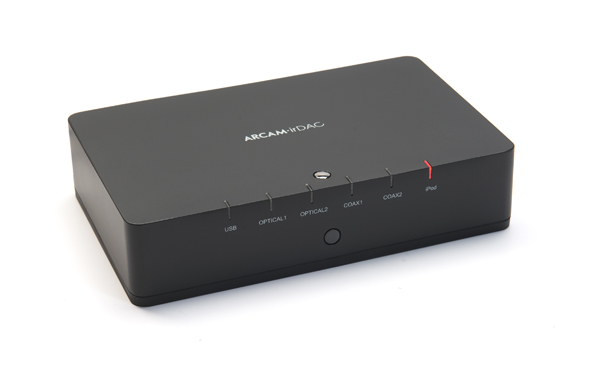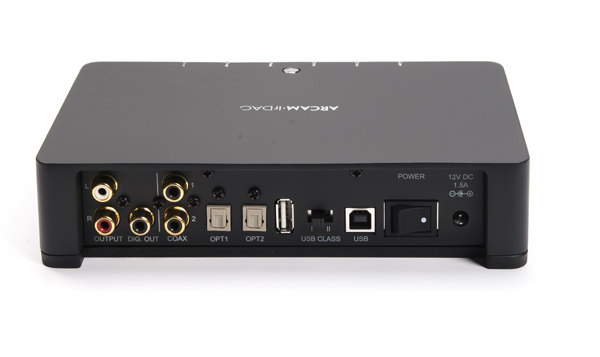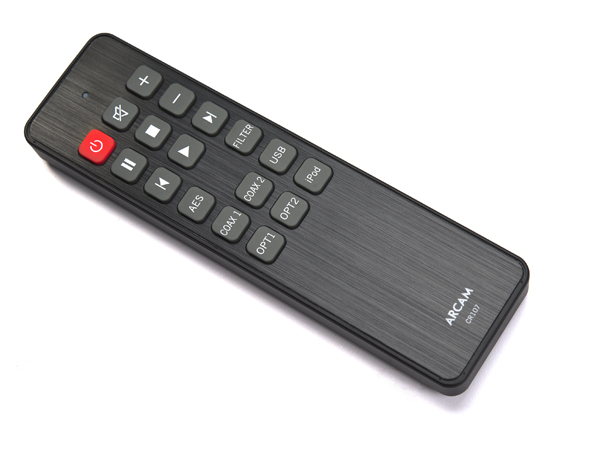Arcam irDAC
 There’s something about visual and operational simplicity that resonates with me, which is why I’m drawn to Arcam’s irDAC ($700), an understated unit about the size of a John Grisham paperback novel.
There’s something about visual and operational simplicity that resonates with me, which is why I’m drawn to Arcam’s irDAC ($700), an understated unit about the size of a John Grisham paperback novel.
Its minimalist design is refreshing. The front panel includes white lettering and a thin green LED for each input and a small remote sensor; the top panel includes just the Arcam irDAC moniker and a small round power button. Though the unit is just 7 inches wide, the back panel, while crowded, still allows for easy gripping of wires. It includes L/R analog outputs, an RCA digital out, two coax, two optical, USB-A and -B and a USB switch, and a power toggle and input for the external power brick.
The irDAC sounds mellow right out of the box. After about 100 hours of constant play, the depth opens up, creating an easier and more expansive soundstage. Credit the Arcam engineers for a design consisting of the Texas Instruments PCM796 chip, isolated digital and analog stages, and eight total power supplies—not to mention Arcam’s well-known emphasis on minimal noise and jitter. The two optical, two coaxial, and USB-B inputs are all 24-bit/96-kHz asynchronous without a driver, and 24/192 once the software is downloaded and installed.
Playing various file sizes, the irDAC consistently offers up easy musicality. Don’t expect it to push music to the sonic cliff; it stays a couple of steps back from the precipice, but remains smooth, which still an excellent place to be for this price.
Arcade Fire’s “Keep The Car Running” is always too harsh to play from my iPhone into my reference system, but with the irDAC, this track comes through with greater ease. Barry White’s “I’ve Got So Much To Give” is the definition of smooth, and the Arcam presents it naturally, never sounding harsh or overly digital. Not so long ago, this level of musicality used to cost a lot more. You may not be able to tell whether the cymbal is located 6 or 6.5 inches from the center of the mix, but you’ll appreciate the presentation nonetheless.
Playing the Bill Evans Trio, the irDAC sounds relaxed, but it still gets the essence and energy of the high-frequency content in “Swedish Pastry.” Throughout the At Shelly’s Manne-Hole recording, the piano is easy and laid back, much like the club it was recorded in, and the irDAC resolves enough detail to pick up the distant voices in the audience.
When it’s either/or, this reviewer always prefers a natural presentation to the final bit of resolution. The last time our staff was this smitten with an inexpensive DAC was the Neko Audio D100 (priced at about $1,100), making the irDAC an absolute steal for $700. Portraying the nuances in Elvis Costello’s “Veronica,” the irDAC is nipping at the heels of my current reference, the Simaudio 300D.
Between the balance of the harp and the deep notes of the horn in Sinatra’s “Nice ’n‘ Easy,” or the delicacy of the clarinet and oboe lushly presented in Beethoven’s Ninth, the irDAC’s complete absence of shrillness allows hours of non-fatiguing listening—something budget DACs never used to be capable of.
How non-fatiguing is the irDAC’s sound? A nearly eight-hour eulogy-writing marathon that should have left me alternating between music and silence instead triggers a relaxed flood of creativity. And I find myself digging deeper into my digital jazz collection.
With the irDAC, the lossless streaming service TIDAL sounds just as terrific from my MacBook music server as it does from my iPhone, via the iPod port. The irDAC and the $20-per-month TIDAL service is a fantastic combination for those craving good sound and a large music library on a limited budget. The ability to access the digital signal from an iDevice is a major bonus. A friend comes over with a few tracks on his iPhone, and we’re listening within moments. Sadly, the Arcam does not recognize the iPod Classic, a mainstay of many audiophiles, so perhaps the company will address this in a future firmware update.
Oftentimes, products in the sub-$1,000 category come with “yes, but” at the end of the review. This is not the case with the Arcam irDAC; it performs all the critical functions with ease and provides every input type necessary for complete digital integration. It’s so good that our publisher has decided to purchase the irDAC as TONE’s reference in the sub-$1,000 category—and we happily give it our first Exceptional Value Award of 2015. -Mark Marcantonio
Arcam irDAC
$700




